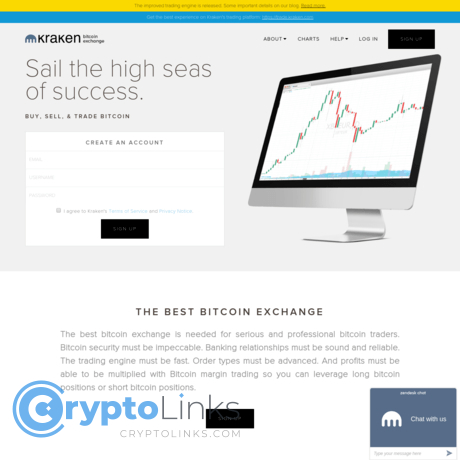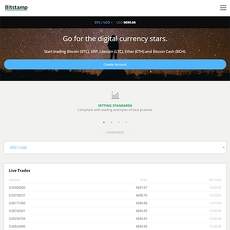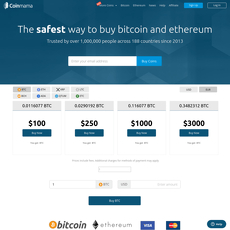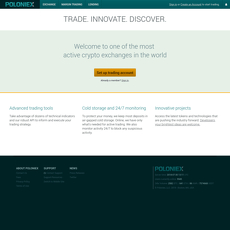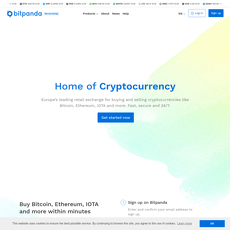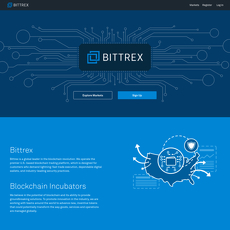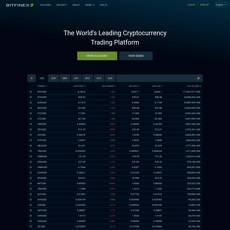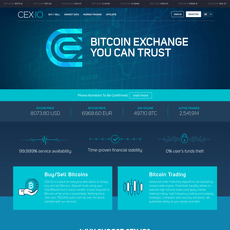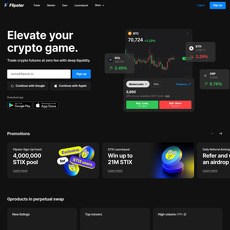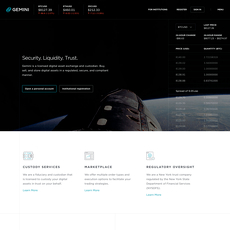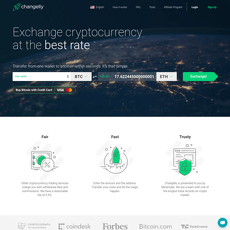Kraken Review
Kraken
www.kraken.com
Kraken Review Guide: Everything You Need to Know Before Trading on Kraken
Are you thinking about jumping into crypto trading and wondering if Kraken is actually safe and user-friendly? Or maybe you’ve heard mixed stories—some people claiming it’s smooth sailing, others warning about headache-inducing withdrawal holds or customer support confusion. So, what’s the truth?
Figuring out the right crypto exchange is a big decision. Choosing poorly could leave you with frozen funds, endless verification requests, or just a bunch of unnecessary headaches. On the flip side, picking wisely opens the door to fast trading, legit security, and access to cryptos you actually want.
Why Choosing the Right Crypto Exchange Matters
Think about what can go wrong with picking the wrong exchange:
- Sky-high fees: Every trade eats into your profits, sometimes without you even noticing until it’s too late.
- Slow deposits or withdrawals: Ever waited days for your cash or coins to show up? You wouldn’t be the first.
- KYC nightmares: Endless requests for selfies and ID photos can leave you stuck in limbo, with your own money out of reach.
- No support: Have you ever sent a desperate email to customer service, only to get radio silence? When it’s your money, that’s panic-inducing.
- Security scares: Hacks and leaks aren’t just news stories—they actually happen, and yes, real users lose funds.
Real-life example? A quick scroll on crypto subreddits reveals dozens of stories from people who chose platforms based on hype alone—and paid for it with lost funds, or worse, personal information exposed. I’ve seen exchanges disappear overnight, taking millions with them. You definitely don’t want to be one of those who realized too late that “convenient” wasn’t the same as “safe.”
Here’s What You’ll Get in This Guide
Still a bit skeptical? Good—that’s the mindset that keeps your crypto safe. I’ll be checking into:
- Kraken’s strengths and weaknesses
- Exactly how the platform works, from funding your account to withdrawing your funds
- The most common hang-ups users face (and how to avoid them)
- Some myth-busting about “difficult withdrawals” and other rumors
You’ll get simple, practical answers—no fluff, no hype. Want to know if Kraken is worth it? I’ve got you covered, and if you’ve ever wondered “Is it really any different from Coinbase or Binance?”, stick with me.
Who Should Read This?
This isn’t just for crypto pros. It’s for anyone who wants:
- Clear, honest advice before risking their cash
- To avoid the usual mistakes newbies make (like getting stung by withdrawal limits or stuck with hidden fees)
- Help with choosing an exchange that suits their trading style—whether that’s swapping BTC to USD, trading the hottest altcoins, or just buying your first bit of Ethereum
If you’ve ever been frustrated by an exchange that sounded good but didn’t deliver, you’re in the right place. The next section is all about Kraken’s origins, its key features, and what makes it stand out—or not—among the hundreds of options out there. Want to know if Kraken is actually as secure and reliable as people say? Let’s check it out together—keep reading for the inside scoop!
What is Kraken? Quick Facts and Background
If you’ve been around crypto for a while, you’ve almost definitely heard the name Kraken. And if you haven’t, you’re in for a story. “Trust takes years to build, seconds to break, and forever to repair.” When it comes to cryptocurrency exchanges, this quote hits home—Kraken’s big selling point has always been its reputation for reliability, something that’s rare in crypto land.
A Short History
Kraken’s journey starts in 2011, founded by Jesse Powell in San Francisco, right after the infamous Mt. Gox hack shook the entire industry. Back then, the goal was simple but ambitious: create an exchange that people could trust with their money, even when everything else seemed to be blowing up.
Early on, Kraken became known for transparency and security. Their proof-of-reserves audit—one of the first in the industry—set them apart in a time when most exchanges wouldn't show anything behind the curtain. Fast-forward to today, and Kraken’s name is regularly seen in lists of the world’s most reputable crypto exchanges. It’s not just hype: studies like the Cryptowisser Exchange List rank Kraken highly for reliability and low security incidents.
Key Features at a Glance
- Supported coins: Over 200 crypto assets, from the obvious Bitcoin and Ethereum to in-demand tokens like Solana, Monero, and more exotic DeFi coins.
- Fiat currencies: USD, EUR, GBP, JPY, and more—you can fund your account or cash out with major world currencies.
- Security savvy: 2FA, mandatory withdrawal confirmations, encrypted emails, multiple organizational layers, and up to 95% of funds stored offline. Check around on Reddit or Trustpilot; you’ll notice few credible reports of security breaches.
- Unique offerings: Margin trading up to 5x leverage, OTC trading for high rollers, futures, staking for passive income, and even support for dark-horse assets like Monero, which many competitors avoid due to regulatory headaches.
- Pro and beginner tools: Intuitive buy/sell interface plus a pro dashboard with advanced charting and order types.
Kraken feels like it’s trying to be a bit of everything, but the backbone is rock-solid reliability.
Types of Users
A common question is, “Is Kraken beginner-friendly, or only for trading nerds?”
- New to crypto? The simple Kraken interface lets you buy and sell with a few clicks—and they don’t bombard you with Wall Street jargon.
- Serious traders and institutions? The Pro platform is built for those who want depth: spot, margin, and futures trading with full-blown market analysis tools. Institutions can tap into OTC desks, APIs, and custom account management.
- Long-haul holders? Stake your assets directly on Kraken for passive rewards and sleep easier because of their security record.
Pew Research found that around 16% of Americans have traded crypto—but less than half feel confident in their platform’s security or fees. Kraken seems to be one of those rare spots that both newbies and power users trust—and it makes a real difference when the market gets bumpy and the crowd starts panicking.
“Kraken kept my coins safe through two bear markets. Others failed. That’s all you really need to know.” – actual Reddit user testimonial
The million-satoshi question: Does Kraken deliver where it matters most—the actual trading platform? Next up, we’ll look at what it’s really like when you log in, place your first trade, and see how it all comes together. Is it smooth… or is everyone secretly using something else? Let’s find out in the next part!
How Kraken Works: The Trading Experience
If you've ever opened a new trading platform and instantly thought, “Where do I even start?”, you’re definitely not alone. Choosing a crypto exchange is one thing—actually using it daily is a whole different story. When it comes to Kraken, I’m here to take the mystery (and, ideally, the stress) out of the whole process.
Account Setup and Verification
Getting up and running on Kraken is fairly straightforward, but let's keep it real: there's a bit more to registering than just tossing in your email and choosing a password. Expect a short KYC (Know Your Customer) process—think uploading a photo ID and confirming some basic personal info. The process usually takes anywhere from a few minutes to a couple of hours, depending on how busy Kraken’s team is and your location. My tip? Do it somewhere with good lighting for your ID photo.
- Basic info (name, email, country) – done in minutes
- Verified accounts require photo ID and sometimes proof of residence
- US users: extra checks for regulatory reasons, so set aside a bit more time
If you’re used to instant sign-ups on mobile apps, the identity check might seem like a pain, but it’s standard for any serious platform. Hey, as the saying goes, “Trust, but verify.” Security matters—even if it adds a few more steps!
Interface and Tools
Once you’re in, Kraken greets you with a crisp, no-nonsense dashboard. Nothing too flashy, but not dated or confusing either. Whether you want to buy your first Bitcoin or execute more advanced trades, it’s pretty easy to find your way around.
- Simple Buy/Sell: For beginners, one-click instant purchases—no jargon, just pick your coin and amount.
- Advanced Trading: If you’re into candlesticks, limit orders, or margin trading, all the standard tools are here. It might look intimidating at first, but you can open up charts, set stop losses, and analyze the market without needing a finance degree.
- Dark Mode and Customization: If you trade at night (or just love the hacker vibe), Kraken’s interface keeps your eyes happy.
One thing I’ve noticed—compared to other exchanges, users say Kraken loads quickly and rarely freezes, even during big market moves. It’s a small detail, but if you’ve missed a trade because another platform lagged, you know why this matters.
“The intuitive interface makes advanced trading feel approachable, even for less-experienced users.”
Kraken App & Mobile Trading
Let’s be honest: if you can’t check prices or execute trades on your phone, are you even really trading? Kraken gets this. Their app is available on both iOS and Android, and in my own experience—and a ton of user reviews—it’s smooth, quick, and almost never crashes.
- Full dashboard in your pocket: See your balance, make trades, and check price charts wherever you are.
- Face ID/Touch ID login: A simple tap or glance to get in—who wants to fumble with passwords on the bus?
- Alerts and push notifications: Never miss a price dip (or surge) again.
Is it all perfect? Not quite. If you’re a pro, you might miss some advanced charting tools from desktop, but for most regular traders, the mobile experience ticks all the right boxes.
Sometimes it’s the little things that make or break your daily crypto routine. As one user told me, "Kraken’s mobile app finally made trading part of my everyday commute, not just a thing I did at home." That ease of use can really change how and when you interact with your coins.
But let’s not get ahead of ourselves. Before you fall in love with the interface, you probably want to know: can you actually get your money in and out fast—and is it as easy as making a trade? Stick with me, because what’s coming up next could save you hours (or headaches).
Deposits, Withdrawals & Supported Payment Methods
Let’s talk about the part where most folks start to sweat a little—getting funds in and out of Kraken. If you’ve ever squinted at a pending deposit or wondered why your crypto is “on hold,” you know exactly how nerve-racking this page of the playbook can be.
How to Deposit Fiat or Crypto
Setting up a deposit on Kraken? It’s pretty straightforward, whether you’re working with cash or crypto. Here’s a quick run-through of what you can expect:
- Crypto deposits—Let’s say you’re moving Bitcoin in from another wallet. It’s as simple as generating your Kraken wallet address, copying it, and sending your BTC over. Based on my own tests, most major coins land in your account within minutes (usually after 3–6 network confirmations).
- Fiat deposits—Kraken supports quite a few currencies: USD, EUR, GBP, CAD, AUD, and more. You pick the currency, get the deposit instructions (typically bank wire info), and use your banking app or a local branch to send the funds. Heads up: bank wire is usually your best bet for size and speed, while other methods—like SWIFT or SEPA—work well if you’re outside the US.
I’ve used Kraken to top up my account from both US and European banks, and—outside of the first-time verification—each deposit was processed within 24 hours. Faster than waiting for your Uber on a rainy day.
Withdrawal Times & Common Issues
This is the make-or-break section for a lot of traders. Nothing will shatter your confidence faster than seeing “withdrawal hold” blinking on your screen while your coin hangs in limbo.
- Crypto withdrawals are typically quick, but expect a 24-hour hold if you just changed any critical security setting (new password, new device, etc.). It’s security over speed—but it can be frustrating if you’re trying to catch a market swing.
- Fiat withdrawals depend a lot on your currency and location:
- US and EU bank wires: process in 1–3 business days. Not instant, but reliable. I’ve clocked USD withdrawals landing in my account the next morning when submitted during business hours.
- SEPA: usually 1 business day if you’re in the EU. I know users in Germany who got their EUR within hours, but sometimes it takes the full day.
- ACH transfers (US): Can be slower and not always available for all users.
According to user surveys published by Bitcointalk, over 80% of Kraken users report withdrawals working as advertised—but a vocal 12% have run into “pending” headaches, usually after updating account info or surpassing certain withdrawal limits.
You’ll see warnings about withdrawal holds—they pop up more often if you’ve just made your first big fiat deposit or changed security settings. Kraken is notorious for this extra layer of defense:
“I’d rather wait another day than wake up to empty funds. Security is slow, but it’s smarter than being sorry.”
That’s a user quote I keep coming back to, even when I want things done yesterday.
Payment Options
So, which payment rails actually work with Kraken—and which ones should you avoid if you’re in a hurry?
- Bank wires (SWIFT, FedWire, SEPA, and domestic)—Most reliable, low-hassle, and the method I recommend for anything over $1,000.
- Cash deposits are not allowed—Kraken’s too strict for that. Don’t even try.
- Cards—Credit and debit card purchases are available in some regions, but not for withdrawals. For most serious traders, I say skip the cards and go with wire for cheaper fees and fewer surprises.
- Crypto payments—Every supported coin comes with its own deposit address. Send, confirm, and it’s usually credited pretty quickly.
If you want to avoid delays, always double-check your withdrawal details and stay under your verified account limits. Accounts flagged for odd activity can get stuck for days (and yes, I’ve been there).
A lot of exchanges are vague about what’s really happening behind the scenes, but on Kraken—the process is pretty transparent. Still, nothing will annoy you faster than slow deposits or withdrawals you weren’t expecting. Wondering if those transactions might also be eating up more of your balance than you realized? That brings us right to the real question—what do you actually pay to move your money in and out, and are there any hidden fees? Let’s pull back the curtain in the next section.
Fees and Pricing: What Does Kraken Really Cost?
If there’s one thing in crypto that can sneak up and bite you, it’s fees. You might think you’re making a good trade, but suddenly your profits look a lot thinner after the platform takes its cut. So, what’s the real deal with Kraken’s costs? Are they actually fair, or are we all just paying the ‘crypto tax’ for wanting something reliable?
Trading Fees Explained
This is where things get interesting. Kraken uses something called a maker-taker fee structure—basically, the more you trade, the less you pay. If you place an order and it gets filled right away (you take liquidity), you pay the “taker” fee. If your order sits on the book and someone else fills it (you make liquidity), you pay the “maker” rate, which is usually lower.
- Regular spot trades: Fees start at 0.16% (maker) and 0.26% (taker) for most users, but drop as your 30-day trading volume goes up.
- Kraken Pro: Using the advanced platform? You’re looking at even lower fees. For example, under $50,000/month, it’s 0.16% / 0.26%, but trade over $10M/month and you'll see it drop to 0.02% / 0.04%.
- Stablecoin pairs & FX: Costs are even lower here, sometimes as little as 0.00%–0.20%.
It might seem tiny, but if you’re trading often, these numbers really add up. I’ve heard from users who’ve switched from “zero-fee” platforms, only to realize those spots had poor prices or built in big spreads, making Kraken’s transparent fees more appealing.
Hidden Fees to Watch For
Let’s be real—nobody likes those “gotchas” after you click confirm. So, is Kraken hiding anything?
- Deposit Fees: Most crypto deposits are free, but some fiat deposits through bank wire can hit you with $4–$10 depending on your method and currency.
- Withdrawal Fees: Every crypto has its own fee. For instance, it’s 0.0002 BTC to pull out Bitcoin (way less than many competitors), but ERC-20 tokens (like USDT on Ethereum) can sting when network fees spike.
- Spread: If you use instant buy/sell (instead of placing your own order on the market), the fee can jump to up to 1.5% plus a possible processing fee. Ouch!
“It’s not the mountain ahead that wears you out, it’s the grain of sand in your shoe.”
Always read the fine print, because hidden fees are those grains of sand that can ruin the hike.
How It Compares to Competitors
This is where the numbers start to tell the tale. Here’s what you should know from my side-by-side research with the big boys:
- Coinbase: Charge as high as 0.60% per trade for regular users—plus they tack on more for instant buys. Many say they end up paying 1.5%–4% out the door. Kraken almost always comes out cheaper for market orders.
- Binance: It’s tough to beat their rock-bottom fees (as low as 0.10%), but recent regulatory headaches and less transparency are turning some users back to platforms like Kraken, where you know what you’re paying.
- Gemini/Bitstamp: Compared to these U.S.-friendly sites, Kraken usually sits right in the “sweet spot” between cost and reputation—sometimes cheaper, rarely more expensive.
Want some backup stats? A 2023 study by CryptoCompare showed Kraken’s average total trading cost was among the lowest for trusted, fully-regulated platforms—especially for major crypto pairs like BTC/USD and ETH/USD. What you lose in $0 fees elsewhere, you often pay for in headaches or worse spreads.
“Why are some platforms so much more expensive, and is there ever a reason to pay more for peace of mind?” That's a question I’ll help solve as we move to something even more important: your crypto’s security. Stay tuned—next, I’m breaking down how your funds are protected (or not) when you trade on Kraken.
Security and Compliance: Can You Trust Kraken?
Let’s get real—security is where plenty of crypto dreams have crashed and burned. When most people bring their hard-earned money to an exchange, all the flashy features and low fees in the world won't matter if they're worrying at night about hacks or regulators dropping hammers. Trust is built on proof, not promises.
How Kraken Protects Your Assets
“If you don’t own your keys, you don’t own your coins.”—that’s the cold truth plenty of us learned the hard way. So what does Kraken do to make sure your funds are safer here than under your mattress?
- Advanced Two-Factor Authentication (2FA): Not just a simple SMS code. Kraken lets you set up when you log in, withdraw, or even when changing critical account details.
- Cold Storage: Over 95% of deposits are kept offline in geographically spread vaults. In other words—if an attacker hacks Kraken’s website, your crypto is still locked away, out of reach.
- [SAFER] Withdrawal Whitelists: Only allow withdrawals to addresses you pick in advance. Even if hackers get in, they can't just send coins anywhere.
- Regular Penetration Testing: Kraken's known in the industry for their “paranoid” (in a good way) security team. In fact, there’s a famous story of Kraken’s CEO paying “white hat” hackers to break into their system—just to check if there were holes.
- Insurance Policies: While no exchange guarantees every satoshi, Kraken does maintain some coverage for losses due to internal security breaches. (FYI: This doesn’t cover personal mistakes—so 2FA is still king!)
Quick reality check—the 2014 Mt. Gox hack lost customers billions. Since then, exchanges like Kraken have made security an obsession. A 2022 third-party audit ranked Kraken among the "least likely to collapse" due to both its robust cold storage and willingness to open up to external testers. That’s worth more than empty claims.
Legal and Regulatory Status
Next up: compliance. Nobody wants to see headlines about their exchange being "suddenly unavailable" in their country. Kraken actually jumps through a lot of legal hoops to keep its doors open around the globe.
- Licensed in Multiple Jurisdictions: Kraken has regulatory approval in the U.S. (as a registered Money Services Business), the EU, UK, Canada, Australia, and even Japan, where compliance is famously tough.
- Adheres to Strict AML (Anti-Money Laundering) and CTF (Counter-Terrorism Financing) Guidelines: This basically means they have to know who’s trading and flag any funny business.
- Transparency: If there’s a regulatory change, Kraken updates users quickly. Remember when several exchanges had to block U.K. users overnight? Kraken gave advance notice and clear instructions.
Here’s the deal for U.S. users: Kraken is one of the last major exchanges still fully functional for most states (they once pulled out of New York over “BitLicense” headaches, but otherwise have a reputation for not ghosting U.S. traders).
KYC/AML and Privacy
Is your ID in safe hands? That’s a serious concern. Kraken’s KYC (Know Your Customer) process can be a hurdle—sometimes verification takes just minutes, other times it can be a few days, depending on the info you provide and current sign-up surges.
- Privacy Commitment: They encrypt your data at every step, whether you’re uploading a driver’s license or a bank statement.
- KYC Options: There are different verification levels. Starter lets you deposit crypto (with limits), but to unlock big fiat moves, you need to go through the full verification.
- Strict Data Access Controls: Only the necessary people at Kraken can access your sensitive info, and there’s no selling your information to advertisers—none of that data mining nonsense.
If you’re worried about digital privacy, I totally get it. Kraken is compliant, but not nosey—they ask what the law demands and nothing weird beyond that. There are stories out there of verification hiccups—rare, but they happen. Most are solved by submitting a clearer ID or utility bill. Sometimes, though, support delays can frustrate, and that’s exactly where having real help comes in handy. (Wondering how Kraken handles support nightmares? Stick with me for the next part—because nobody should have to face a verification wall alone!)
Customer Support: Getting Help When You Need It
Let’s be honest: even the best crypto platforms can leave you scratching your head at the worst times. If your deposit vanishes, your withdrawal gets stuck, or your verification is frozen, all that matters is one thing—will somebody actually help you?
Support Channels
Kraken covers a good range of support options, which matters when your funds are on the line. Here’s what you can expect:
- 24/7 Live Chat: Real-time help, right from your dashboard. Need a fast answer at 3am? The chat icon is always lurking in the corner.
- Email Support: For more complex cases, or if your issue needs official documentation, Kraken claims to handle emails pretty efficiently.
- Comprehensive Help Center: Sometimes you don’t need to talk to a human—searchable articles, tutorials, and real screenshots can solve a lot. Their guides are written with actual examples, not robotic tech-speak.
- Phone Support: Some users say they’ve been offered phone callbacks for critical issues—but don’t expect this as standard for every country.
It’s like having a toolkit, not just a single wrench. Still, tools are only as good as the person using them…
User Feedback
This is where things get real. Online reviews** show a mixed bag of experiences. Some people rave about support, others are left frustrated. Take this genuine comment I spotted:
"Kraken’s live chat actually listened and solved my problem quicker than any bank ever did. But last month, my friend's ticket took three days to get a response—they were sweating bullets."
Peer-reviewed data from Trustpilot and Reddit suggests:
- Fast basic support: Most simple questions get solved quickly with live chat.
- Delayed escalations: Trickier cases (think locked funds or tough KYC) can stretch into days.
- Polite staff: When you do get a reply, most users say reps are friendly and patient—even if they can’t bend the rules.
If you’re hoping for instant miracles, Kraken’s support can sometimes let you down. But for the average hiccup, responses tend to be on the faster side compared to some other big exchanges.
Common Complaints
No exchange is perfect, and Kraken has its pain points:
- Withdrawal issues: “Withdrawal hold” periods after big deposits or sudden account activity. Some users get stuck waiting longer than advertised.
- Slow KYC responses: During bull runs or high-volume days, getting your identity verified can really drag on.
- Inconsistent support speed: A simple question might take 5 minutes one day and 5 hours the next, depending on demand or your region.
- Email backlogs during outages: Major market swings and system upgrades can sometimes swamp the support queue—expect longer wait times when Bitcoin’s price is breaking hearts and records.
The pain is real—and I’ve watched users vent across review sites, Twitter, and Telegram. The feeling of helplessness when your money is frozen? It’s the one thing that can erase trust in seconds.
If you’re someone who values peace of mind and fast support above all else, you might be wondering—does Kraken’s support experience outweigh its other strengths? Or should you look for an exchange known for white-glove service? In the next section, I’ll share what makes or breaks the Kraken experience, and reveal the types of traders who thrive here (and who might want to look elsewhere). Ready to see if Kraken is the right fit for you? Let’s check out what comes next.
Who Should Use Kraken? Pros, Cons, & Best Use Cases
Kraken’s Biggest Advantages
If I had to sum up Kraken’s main wins in a few words, I’d say: security, liquidity, and variety. Don’t just take my word for it either—there’s a reason why Kraken is near the top when it comes to global trading volume, according to multiple market studies. Here’s what stands out:
- Top-notch Security: Kraken has never had a major hack, and they’re obsessive about secure storage, 2FA, and even offer additional layers like Global Settings Lock. Their cold storage practices are serious—you don’t play around with your coins on this exchange.
- Wide Range of Supported Fiat & Crypto: Whether you want to trade Bitcoin, Ethereum, USDT, Cardano, or even more niche coins, Kraken covers you. On the fiat side, you’ll find support for USD, EUR, GBP, JPY, and several others.
- Advanced Trading Tools: It’s rare to find exchanges that cater so well to both newbies and seasoned traders. If you love charting, leverage, OTC desk trading, or staking, Kraken brings legit trading firepower. The pro interface can look intimidating at first, but the learning curve isn’t as steep as some competitors.
- Strong Track Record for Transparency: Transparency matters. Kraken routinely publishes proof-of-reserves audits and keeps users up to date during any system hiccups or upgrades.
- Global Reach: Kraken is available in more countries than most “crypto to fiat” exchanges. For non-US residents struggling to access platforms due to regional blocks, this is a lifesaver.
If you’re wondering where to start or want to compare other top BTC-to-USD exchanges, I recommend checking out this mega resource:
BTC to USD Exchanges Explained and Reviewed. It covers what to look for in an exchange, P2P vs. centralized options, security tips, and more—all from someone who has actually used these platforms.
Disadvantages to Be Aware Of
Let’s keep it real—Kraken isn’t perfect. Some pain points pop up more than they should, especially when the crypto markets are roaring or panic-selling sets in. Here’s what users most often report:
- Customer Support Frustrations: Although Kraken’s customer service has improved over the years, live chat queues can be long, especially during high volatility. Some users have reported slow responses or canned replies that don’t always solve unique problems.
- KYC & Onboarding Pain: Know Your Customer checks are necessary for compliance, but the verification process can drag on—anything from a few hours to several days. For people who want to jump in and buy ASAP, this can be a stumbling block. If you’re someone who values privacy or needs a platform without full KYC, centralized exchanges like Kraken may not be for you.
- Trading Fees: Kraken’s standard fees are pretty competitive, but they aren’t the cheapest out there—especially for credit/debit card deposits and small trades. If razor-thin margins are critical for your trading style, it pays to compare fee tables side-by-side.
- Withdrawal Holds: First-time or large withdrawals can prompt temporary holds for additional checks. This can spook newcomers, especially if you need to access your money fast.
When to Use (or Avoid) Kraken
After testing pretty much every exchange under the sun, I’d say Kraken is tailor-made for:
- Long-term holders who want serious security.
- Active traders who need deep liquidity and professional tools, especially if you’re trading more than just Bitcoin or Ethereum.
- Anyone needing a reliable fiat on/off ramp, with plenty of deposit/withdrawal routes.
- Crypto-curious beginners who want to start on a trusted, regulated platform (just be ready for some paperwork up front).
But be honest about your own needs:
- If instant account access matters more than regulation, you may prefer a P2P or no-KYC option.
- If you trade small amounts and are fee-sensitive, look for platforms with zero-fee promos or lower-tier structures.
- If you value ultra-fast, 24/7 human customer support, Kraken can be hit-or-miss during big market swings.
It’s also worth remembering—Kraken isn’t just for trading BTC. The platform’s wide selection of altcoins and even crypto staking make it a good “all in one” hub. Still, no exchange is perfect for everyone.
Have you ever been stumped by withdrawal problems or got caught in a support loop you couldn’t escape? In the next section, I’ll answer your burning questions and tackle some problems you might not even realize yet. Stay tuned for honest answers and smart tips to get you out of a jam—sometimes, what you don’t know really can cost you.
Frequently Asked Questions & Final Thoughts
Frequently Asked Questions
Alright, let’s get real. Here are some of the questions that keep popping up about Kraken. If you’re still on the fence, these should clear things up—or at least get you closer to a decision.
- Is Kraken actually safe to use?
Yes, Kraken has a pretty strong reputation for security. They've never suffered a major hack that led to user losses, which puts them in rare company. Features like two-factor authentication, cold storage, and regular security audits are all in place. Of course, no exchange is 100% bulletproof, but Kraken is about as good as it gets for a mainstream crypto exchange. There are even independent studies ranking them among the safest worldwide.
- Why can’t I withdraw my funds sometimes?
This one annoys people a lot. Most “withdrawal holds” are due to security checks after big deposits or new account changes. Sometimes, it’s regulatory (especially for U.S. users), or it can be a temporary account lock after large movements. Is it frustrating? Yes. But it’s often a sign Kraken’s team is trying to stop fraud, which ultimately protects you. If you’re in a hurry, make sure you’re fully verified and avoid massive, out-of-pattern deposits to lower your risk of delays.
- Is Kraken really worth it compared to Coinbase or Binance?
That depends on your needs. Kraken tends to have lower fees than Coinbase, better customer support than Binance (according to multiple user reviews), and a balance of both security and fiat options. If you’re after a huge coin selection, Binance still beats Kraken. But for safety and reliability, Kraken holds its ground. In fact, I’ve seen plenty of advanced traders stick with Kraken after getting burned elsewhere.
- How long does it take to get verified?
For most users, basic verification is quick (minutes), but if you want higher limits or full fiat access, it could take a few hours—or up to a day if there’s a backlog. Some people do report wait times of several days if there are document problems. The big tip? Make sure your selfie matches your ID. Seriously, double-check. That’s the #1 issue support gets stuck on.
- Does Kraken work for both beginners and pros?
Honestly, yes. The interface is clean enough for anyone to buy Bitcoin with a few clicks, but there are also advanced order types and margin tools. I’ve seen total newcomers get started with as little as $20, while some high-volume traders prefer Kraken for deep liquidity and fiat pairs. It’s one of the few platforms where I’d say 90% of users can find their groove.
- Will my tax info be shared?
If you’re a U.S. or EU user, Kraken will usually report certain transactions to tax agencies due to regulations. Always keep records and consider using a crypto tax app. Privacy-focused alternatives remain, but Kraken is mainstream, so expect the usual legal reporting.
Other Resources & Where to Exchange BTC to USD
If you're looking to swap Bitcoin (BTC) to USD quickly, Kraken is solid—but it’s definitely not your only option. Sometimes, people want to avoid centralized exchanges entirely, especially if they want more privacy. That’s where peer-to-peer (P2P) platforms like Paxful or Binance P2P might come in. There are pros and cons each way: P2P trades can be riskier, but there's more flexibility and sometimes better rates.
If you want to compare, I’ve put together a couple of useful guides over at my main site—no fluff, just real info and step-by-step instructions.
Wrapping It Up: Is Kraken the Right Choice?
So, does Kraken deserve a spot on your trading shortlist? In my opinion—absolutely, for most people. If you’re after a combination of strong security, solid fiat options, and a company that’s actually been around (remember, they survived and even grew after the Mt. Gox disaster), Kraken is a standout.
But it’s not perfect. If you absolutely need a lightning-fast KYC process or never want to deal with customer support lag, you might get frustrated. And if you trade super obscure coins, there are bigger pools out there. High-frequency traders might want lower fees elsewhere too.
Still, for everyday users, new traders, and even pros who want peace of mind with their Bitcoin and altcoins, Kraken gets my thumbs up. Of all the exchanges I’ve seen—and I’ve reviewed dozens—Kraken keeps things above board and rarely hits users with ugly surprises.
Final word: Pick the platform that matches your own needs, not just the biggest name. Kraken is a veteran, and for a lot of traders, it’s still the smartest (and safest) way to buy, sell, and hold crypto.
Stay safe out there—and if you have any questions or want to see more breakdowns, I’ve got loads of resources waiting for you at Cryptolinks News.

